A majestic example of Gothic architecture, the 13th century Reims Notre Dame impresses with stained-glass windows and statues, including the iconic Smiling Angel. Indeed, Reims is known as “Coronation City,” as the cathedral hosted the baptism of Clovis around 500 AD and no less than 25 coronations of subsequent French kings.
As impressive as the Notre Dame is, my day focused on Champagne. The UNESCO World Heritage Site “Champagne Hillsides, Houses and Cellars” includes the Colline Saint-Nicaise, located on the southeast edge of Reims. Occupied by Champagne Houses since the late 18th century, the hill offered producers needed space to develop their businesses and – more famously – ideal 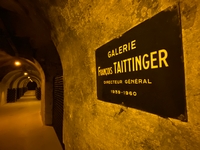 wine storage in the form of the crayères, which were once chalk quarries. Branded “underground cathedrals,” they are a must to see, which I did in a recent visit to the celebrated house of Taittinger.
wine storage in the form of the crayères, which were once chalk quarries. Branded “underground cathedrals,” they are a must to see, which I did in a recent visit to the celebrated house of Taittinger.
Sixty feet underground, 52°F year-round with 80% humidity, the underground Taittinger cellars are ideal for wine. While admiring Methuselah six-liter sized bottles – each equal to eight regularly sized Champagne bottles – my guide explained that the chalk holds up to 50% of its weight in water. Readers may have heard how soldiers fighting in World War I found refuge here, leaving behind drawings, graffiti and initials scratched on the chalk walls. Underground telephone lines can be seen as well. And amongst the seemingly endless carefully piled rows of Champagne, a rare burst bottle, reminding you why Champagne bottles must be thicker than other wine bottles: to withstand in-bottle fermentations.
Taittinger’s famous Les Comtes de Champagne are located in these cellars, patiently maturing for a decade before being released in the market. Yet I had not known that these cellars once belonged to the former Saint-Nicaise Abbey. Considered to be one of the most beautiful Gothic churches in France and having belonged to the family of the “Comtes de Champagne” for a long time, it was 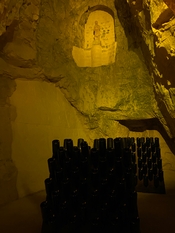 sold as a national asset during the French Revolution and plundered for its stone, until its complete demolition in the 19th century. It was rebuilt in 1920 by Binet Champagne, from whom Taittinger – founded in 1932 – purchased it. Indeed, the abbey’s vaults and ancient underground chalk quarries, dating from the Gallo-Roman era, remain remarkably intact for us to see today along with so many Champagne bottles. During the underground tour we paused before an inscription marking an April 1717 visit by Russia’s Tsar Peter the Great, pondering how much more enlightened a ruler he was for Russia when compared to the brutal Vladimir Putin today. On a more enjoyable note, 70,000 visitors explore the Saint-Nicaise chalk quarries these days, where some two million Taittinger bottles are stored.
sold as a national asset during the French Revolution and plundered for its stone, until its complete demolition in the 19th century. It was rebuilt in 1920 by Binet Champagne, from whom Taittinger – founded in 1932 – purchased it. Indeed, the abbey’s vaults and ancient underground chalk quarries, dating from the Gallo-Roman era, remain remarkably intact for us to see today along with so many Champagne bottles. During the underground tour we paused before an inscription marking an April 1717 visit by Russia’s Tsar Peter the Great, pondering how much more enlightened a ruler he was for Russia when compared to the brutal Vladimir Putin today. On a more enjoyable note, 70,000 visitors explore the Saint-Nicaise chalk quarries these days, where some two million Taittinger bottles are stored.
Comtes de Champagne
While savoring the superb 2008 vintage – both regular and rosé – of Taittinger’s premium Comtes de Champagne blend, I also learned the origin its 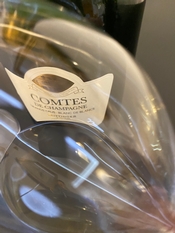 nomenclature: a dynasty of the Comtes de Champagne ruled Champagne between 956 and 1284. The dynasty encouraged an economic boom by holding Champagne fairs, which were important trading hubs in Europe. The Comtes de Champagne oversaw an increased political influence of Champagne, by supporting religious and chivalric orders and the first crusades. Their official “Comtes” residence was of historical and architectural significance, built as a unique, integrated whole in the Middle Ages, and it included the “Maison des Musiciens,” which had alcoves on its façade to house six statues of musicians, considered to be some of the most beautiful examples of secular art in Medieval Europe.
nomenclature: a dynasty of the Comtes de Champagne ruled Champagne between 956 and 1284. The dynasty encouraged an economic boom by holding Champagne fairs, which were important trading hubs in Europe. The Comtes de Champagne oversaw an increased political influence of Champagne, by supporting religious and chivalric orders and the first crusades. Their official “Comtes” residence was of historical and architectural significance, built as a unique, integrated whole in the Middle Ages, and it included the “Maison des Musiciens,” which had alcoves on its façade to house six statues of musicians, considered to be some of the most beautiful examples of secular art in Medieval Europe.
Bombed in World War I, the residence was almost entirely destroyed, but Taittinger Champagne purchased it and oversaw its restoration, with guidance from the French Ministry of Fine Arts. Another project is also under way to restore the Maison des Musiciens, which today retains its medieval vocation as a place to hold prestigious receptions and celebrations. Evening events, exhibitions and concerts are all hosted here. A bottle of Comtes de Champagne can be amazing – and so is its impressive history.
The refined Comtes de Champagne Blanc de Blancs 2008 comes across as chiseled and opulent with aromatic complexity of pear, lemon peel and brioche presaging a linear yet almost lavish palate. I love the fine bead and texture leading to a finish that hints at truffle, but still rather primary and toasty (certainly no hazelnut). It is crafted from Chardonnay vines from five grand cru villages in the Côte de Blancs (Avize, Chouilly, Cramant, Oger, Mesnil-sur-Oger). Worth noting is that this cuvée is created using juice from the first press only, with a small percentage (5%) of the blend aged in new oak barrels to accentuate a balance of toasted notes in the final wine. It is aged about 10 years in the chalk quarries beneath Saint-Nicaise. 98/100. I also tasted the 2011, which is smooth and refined but not quite as dense or as long on the palate. Still, a very fine vintage. 95/100
The Comtes de Champagne Rosé 2008 is made of 40% Chardonnay Grands Crus from prestigious Côte des Blancs terroirs combined with 60% Pinot Noir (Blanc de Noirs) sourced from the Montagne de Reims Grands Crus. Long pre-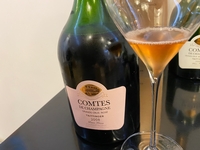 fermentation maceration for some of the Pinots ensures excellent tannic structure with fruit-forward aromas. The vinous aspect to this wine makes it almost as dense as a still red with tannic structure. There is however chalky acidity and freshness, and much aromatic purity, marked by raspberry, black juicy cherry and black currant on the finish. Grand Champagne combining density, elegant salinity and impressive length. Bravo! 98/100
fermentation maceration for some of the Pinots ensures excellent tannic structure with fruit-forward aromas. The vinous aspect to this wine makes it almost as dense as a still red with tannic structure. There is however chalky acidity and freshness, and much aromatic purity, marked by raspberry, black juicy cherry and black currant on the finish. Grand Champagne combining density, elegant salinity and impressive length. Bravo! 98/100
Lunch at Le Parc: Michelin Two-Star
After the morning tour and tasting at Taittinger, it was off to lunch at the aptly named Les Crayères, a magnificent hotel on seven hectares of sprawling grounds. Built in 1904, it was once home to the noble French de Polignac family, and site of the first air show in France in 1909. Partly destroyed in World War I, it was rebuilt to an identical neo-classical style in 1920. During the Second World War, it housed various command posts, both allied and German.
After the war, descendants of the de Polignac family lived there from 1947 to 1980 before selling it in 1983 to the Gardinier family (former owner of Château Phélan Ségur in Saint Estèphe). The family hired Gérard Boyer as executive chef, and by the time he retired in 2003, the gourmet restaurant Le Parc had acquired three Michelin stars while the estate earned “Best Hotel of the World” award from Travel and Leisure and Condé Nast Travel in 2002.
After Boyer’s departure and a transitional period, the hotel has been back on track. Hired at the age of 35, in 2011, Philippe Mille obtained one, and then two Michelin stars, in 2012. Nearly 10 years later over lunch, it became evident to me why Charles Philipponat of the eponymous estate located some 30 minutes-drive further south in Aÿ thinks that it “really deserves three stars.”
The neo-classical building leads to a large entrance into Le Parc, whose expansive rooms and elegant décor sets the stage for a multiple course lunch prepared by Chef Mille, who acquired an impressive resume already before starting here. He had trained at L’Aubergade restaurant in Pontchartrain under Jean Bordier, at Le Drouant under Louis Grondard, at Le Pré Catelan under Frédéric Anton, at Lasserre and then at the Ritz under Michel Roth, at Le Scribe and then at Le Meurice under Yannick Alléno, with whom he won a Paul Bocuse medal.
His cuisine is gastronomic high art, tantalizing the senses both visual and gustatory. Meticulous dedication to fresh ingredients delivered each morning by local producers is matched by amazing presentation.
The choice for the multiple course lunch was of course Champagne, and since I had been at Taittinger that morning, the Taittinger Brut Vintage 2014 was ideal. Blending 50% Pinot Noir and 50% Chardonnay, it comes across refined and smooth, with all the Pinot Noir grapes sources from Grand Cru vineyards, perhaps lending impressive grip to the wine. Crisp expressions of pear and 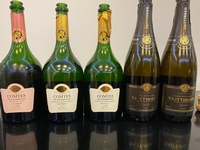 grapefruit and a touch of red (not green) apple excite the palate delivered with fine pétillance, ending with lively citrus notes in a bright and clean finish. 93/100.
grapefruit and a touch of red (not green) apple excite the palate delivered with fine pétillance, ending with lively citrus notes in a bright and clean finish. 93/100.
The Champagne paired well with all dishes served, from amuses bouches to cheeses. The exhilarating four-hour trek began with such servings as farm raised egg yolk with black truffle and potato mousseline: the finesse and intensity of flavor was only matched by visual presentation. Among the main dishes, my overall favorite was the “stained glass” of marinated scampi, in homage to the Notre Dame of Reims. Differently colored sauces neatly arranged near the rim of the plate seemed an inedible, decorative part of the presentation.
The verve of the Taittinger 2014 paired well with John-Dory cooked on a Champagne barrel stave, accompanied by caviar in vine leaf and Champagne sauce and a gorgeously textured, caviar crusted Brill fish with potatoes and Champagne sauce. The structured aspect of the wine also matched the more powerful duck foie gras with local buckwheat, accompanied by Jerusalem artichokes in a Meunier sauce – yet another nod to Champagne.
The fireworks flourished with a show of desserts, for which pastry Chef Yoann Normand is hard to beat. From refined “Champagne leaf to leaf,” combining pear mousse and confit with Champagne Ratafia and Champagne vine bark smoked pear, to grand cru coffee ice cream with grapes matured in Marc de Champagne, a majestic Champagne themed meal – €700 for two – came to an end.
